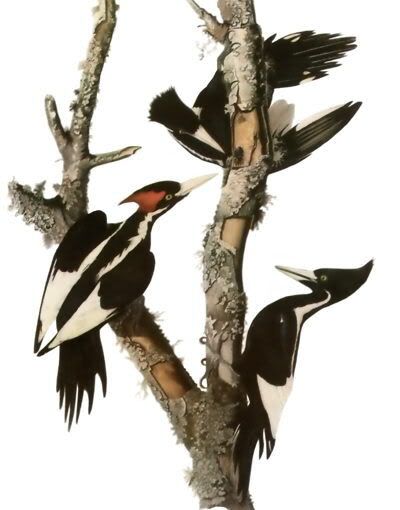
Some environmental battles are emblematic of the movement at large. At the turn of the last century, John Muir’s Hetch Hetchy Valley crusade was such a story. Today, the proposed drilling in the Arctic National Wildlife Refuge generates plenty of ink and airtime. But cases where no battle took place, where the melancholy howl of extinction went unheeded, are often passionately eulogized and become emblems themselves. They serve as unpleasant reminders of what inaction might wrought. The passenger pigeon (Ectopistes migratorius) and the Ivory-billed woodpecker (Campephilus principalis) are icons of extinction.
So it is with great excitement and happiness that I learned, early Thursday morning, of confirmed Ivory-billed woodpecker sightings in Arkansas. (CNN report here. NPR report here.) For the last five years I have followed the search for Campephilus principalis, North America’s largest woodpecker, with much interest. Like the search for mountain lions (Puma concolor) in the mountains of West Virginia and Pennsylvania, the likelihood of discovering remnant Ivory-billed populations, particularly viable ones, was minimal at best.
In the 1930s, Campephilus principalis was confined to one or two remnant populations in Louisiana and Florida. Some biologists believe each population (if there was more than one) numbered 10 or fewer birds. Because of the Ivory-billed woodpeckers’ refined dietary needs – the species has evolved to specialize on cerambycid beetle larvae most commonly found “under the bark of recently dead or dying hardwoods” – heavy logging pressure through the 1930s and 1940s devestated the birds.
Upon waking for work on an April morning in 2005, over 60 years after the last confirmed sighting (in the United States; one was spotted in Cuba in 1986), my Inbox was crowded with emails from various biologists (members of any number of listservs that I subscribe to) relating the news. In spite of some skepticism, the news elated me. My good spirits were only slightly dampened by the reaction of my co-workers, which ranged from “Oh, that’s nice,” to “Have you seen my umbrella?” One office-mate did seem interested, and he told me that he has spotted numerous Ivory-billed woodpeckers in his life. I attempted to explain the visual similarities between the Ivory-billed and the smaller, more common Pileated woodpecker (Dryocopus pileatus), but when I opened my bird book – I keep one on hand at work due to the many migratory flights heading up the East River – to show him the difference, I realized there was no Ivory-billed woodpecker depicted. The bird, after all, was thought to be extinct. The import of the discovery sank in!
While the exact location of the confirmed sightings will not be released (in an effort to prevent poaching or undue stress from a crowd of over-eager birding enthusiasts trying to add to their “lifelist”), several conservation groups are already working to extend legal protections on the area in question. Not only will legislation and land purchases help to save the surviving woodpecker population, they will likely aid all the flora and fauna in these woods. Today, unlike the 1930s and 1940s, suitable Ivory-billed habitat exists in many places; some biologists suggest the Ivory-billed woodpecker could turn into a success story along the lines of the California condor (Gymnogyps californianus).
The only dark spot marring an otherwise encouraging discovery is the fear that certain powerful lobbyists will use the Ivory-billed woodpecker to highlight Nature’s resilience. Nature is resilient and wonderful, but one recovery – if, indeed, such a thing is possible for Campephilus principals – does not mean we should continue to plunder the natural world in an immoral and unsustainable fashion.
Photo credit: John James Audubon, "Birds of America"

1 comment:
This is an amazing discovery! I only learned of it today (what are these listservs that you mentioned in your post?). I'm excited and look forward to following the recovery of the ivory bill. Really enjoy your blog. Thanks.
Post a Comment